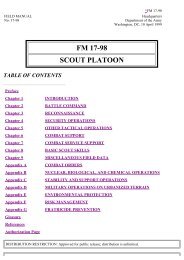FM 3-25.26 MAP READING AND LAND NAVIGATION
FM 3-25.26 MAP READING AND LAND NAVIGATION
FM 3-25.26 MAP READING AND LAND NAVIGATION
You also want an ePaper? Increase the reach of your titles
YUMPU automatically turns print PDFs into web optimized ePapers that Google loves.
logistical planning (top map in Figure 2-1). These are the maps that you as a soldier or junior leader aremost likely to encounter. The standard large-scale map is 1:50,000; however, many areas have beenmapped at a scale of 1:25,000.b. Types. The map of choice for land navigators is the 1:50,000-scale military topographic map. It isimportant, however, that you know how to use the many other products available from the DMA as well. Whenoperating in foreign places, you may discover that DMA map products have not yet been produced to coveryour particular area of operations, or they may not be available to your unit when you require them. Therefore,you must be prepared to use maps produced by foreign governments that may or may not meet the standards foraccuracy set by DMA. These maps often use symbols that resemble those found on DMA maps but which havecompletely different meanings. There may be other times when you must operate with the only map you canobtain. This might be a commercially produced map run off on a copy machine at higher headquarters. InGrenada, many of our troops used a British tourist map.(1) Planimetric Map. This is a map that presents only the horizontal positions for the featuresrepresented. It is distinguished from a topographic map by the omission of relief, normally represented bycontour lines. Sometimes, it is called a line map.(2) Topographic Map. This is a map that portrays terrain features in a measurable way (usually throughuse of contour lines), as well as the horizontal positions of the features represented. The vertical positions,or relief, are normally represented by contour lines on military topographic maps. On maps showingrelief, the elevations and contours are measured from a specific vertical datum plane, usually mean sealevel. Figure 3-1 shows a typical topographic map.(3) Photomap. This is a reproduction of an aerial photograph upon which grid lines, marginal data, placenames, route numbers, important elevations, boundaries, and approximate scale and direction have beenadded. (See Chapter 8. )(4) Joint Operations Graphics. These maps are based on the format of standard 1:250,000 medium-scalemilitary topographic maps, but they contain additional information needed in joint air-ground operations(Figure 2-2). Along the north and east edges of the graphic, detail is extended beyond the standard mapsheet to provide overlap with adjacent sheets. These maps are produced both in ground and air formats.Each version is identified in the lower margin as either Joint Operations Graphic (Air) or Joint OperationsGraphic (Ground). The topographic information is identical on both, but the ground version showselevations and contour in meters and the air version shows them in feet. Layer (elevation) tinting andrelief shading are added as an aid to interpolating relief. Both versions emphasize airlanding facilities(shown in purple), but the air version has additional symbols to identify aids and obstructions to airnavigation. (See Appendix D for additional information. )











